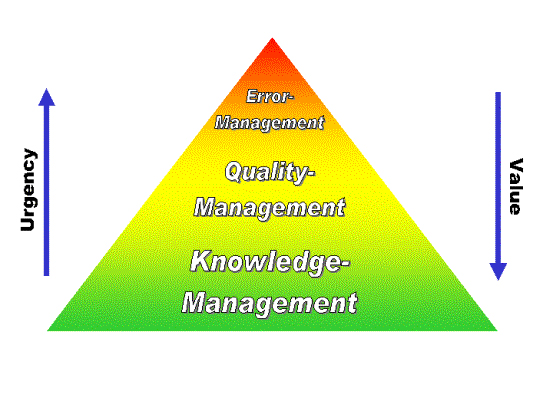

The EQK (Error-Quality-Knowledge)-pyramid
To simplify the ethical discussion of efficient delivery of healthcare is not easy, but if one should attempt to raise only a few central themes for simplicity and clarity most patients probably will agree that its should be:
1. Do no harm,
2. Give the best treatment available
3. Do it as efficiently as possible.
There is no doubt that all organizations and their managers; even the politician try their best in their own ways to follow these rules. To be persuaded, one only needs to take a look at all the different types of “managements” that are practiced (or have been) in the healthcare sector – Error Management, Financial Management, Human Resource Management, Management by Objectives, Project Management, Quality Management, Resource Management, Risk Management and – it seems that one could go on forever. They all serve their special purpose in large complex organizations. Reading the literature it seems that most of these approaches have one major shortcoming in common and it is the lack of interconnection – communications between them. They all attack one problem or one problem complex from more or less one angel. It is too narrow a focus if the aim is to improve large complex adaptive organizations.

Then how does Knowledge Management fit into all this? It is a holistic multidisciplinary way of thinking building on open and available information, honest communication and respect for deviating views but also loyalty to common decisions – some would say more like a culture. Therefore there is no contradiction in having a Knowledge Management culture and using the tools developed for instance for project management as long as these tools are compatible with the principles in Knowledge Management. Just as it would be as legitimate to use knowledge gained from Human Resource Management. Hence Knowledge Management is not seen as a “competitor” or a rival nor is it seen as the system to solve all the problems of modern healthcare. Knowledge Management is perhaps best described as the “sum of all the parts”(1).
When searching for literature with the keywords “Knowledge Management” and “healthcare” one often simultaneously stumble over the terms error management and quality management. Based on the tools, advice and the general descriptions given in the relevant papers one could conclude that the three “managements”; Error -, Quality -, and Knowledge Management are very similar and therefore argue that it confuses the issue more by maintaining a sharp division of the three.
Making the general assumption that the healthcare sector has three major areas that need attention, namely the major ethical issues of do no harm, give the best treatment available, and do it as efficiently as possible. In daily terms the public’s pressure to reduce the high numbers of errors disabling or even killing the patients, as seen in the ‘100K Lives Campaign’(2). Thus the challenges are to provide the patients with the choice of state of the art treatments, based on evidence and do it on time within a given budget. Setting the three “managements terms” – Error Management, Quality Management and Knowledge Management – into the concept of the three major challenges for the healthcare sector one could simplify the meaning of the words.
The Error Management is simply the management approach to minimize the number of errors.
The quality management is simply the management approach to maximize the number of opportunities for patients to chose and receive state of the art treatment and finally
Knowledge Management is the management approach to optimize and develop the overall performance of the organization.
We call this the EQK-pyramid (Error-Quality-Knowledge)
By using the symbol of a pyramid hopeful several principles is better remembered.
First a health care provider should assess where the organization is placed in the pyramid. If it has significantly error rate (only hypothetical it can be nil) then that is the most urgent problem the organization need to attend to. Likewise if it delivers substandard care it should engage in quality management and only if those two areas are covered satisfactory then it is time to embark on Knowledge Management. Hence the bottom-up urgency-arrow and the shift in color from red over yellow to green just as a traffic light – Halt at red.
Secondly the basic culture and ethics behind the three “managements” are more or less the same symbolized with the fact that they all are in the same pyramid. They are largely overlapping hence the floating change in color.
Thirdly fixing errors is only the top of the iceberg hence it is placed on top where its volume is the smallest, fixing the quality is a larger operation hence the larger volume, whereas by far the largest operation is to unveil all the latent knowledge hidden in every corners of the organization and energize it to further optimize and develop the organization. The top-down value-arrow indicates the overall value for the organization. Correcting errors is like distinguish fires. It stops the destruction but does not add any value. With increasing quality value is being added but first when a thorough optimization and new developments take place, then value is really added to the organization.
Reference List
(1) More A. The Was and Is of Knowledge management. Supplement to KMworld 2003; 2003(November/December):s2-s3.
(2) Berwick DM, Calkins DR, McCannon CJ, Hackbarth AD. The 100,000 lives campaign: setting a goal and a deadline for improving health care quality. JAMA 2006; 295(3):324-327.
@ct Consult
Mail to: admin@act-consult.com